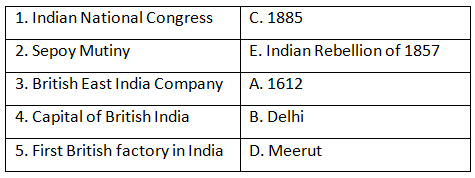India Under East India Company - 1 Class 5 Worksheet SST
Q1: Fill in the blanks
(i) The British East India Company established its first factory in ________ in 1612.
Ans: Surat
The British East India Company initially came to India for trading purposes but gradually extended its control over various parts of the country.

(ii) The Sepoy Mutiny of 1857 was a significant uprising against British rule in ________.
Ans: India
The Sepoy Mutiny of 1857, also known as the First War of Independence, played a crucial role in inspiring the Indian freedom struggle.
(iii) The Indian National Congress was formed in ________.
Ans: 1885
The Indian National Congress was established with the aim of seeking political reforms and self-governance for India.
(iv) The British introduced the ________ system in India, which divided land into administrative units.
Ans: Zamindari
The Zamindari system introduced by the British led to exploitative landownership practices and increased peasant hardships.
(v) The Indian Rebellion of 1857 was triggered by the use of ________ cartridges.
Ans: greased
The use of greased cartridges in rifles issued to Indian sepoys caused religious concerns and was one of the factors that sparked the Indian Rebellion of 1857.
(vi) The capital of British India was shifted from Calcutta to ________ in 1911.
Ans: Delhi
The capital of British India was shifted to Delhi to emphasize the importance of the city in Indian history and as a symbolic gesture of British power.
(vii) The ________ Act of 1935 provided limited provincial autonomy to Indians.
Ans: Government of India
The Government of India Act of 1935 was a significant step towards granting Indians some degree of self-governance through elected representatives.
(viii) The British introduced the ________ in India as a means of communication and control.
Ans: telegraph
The telegraph system introduced by the British played a vital role in improving communication and administrative control over vast territories.
(ix) The ________ movement was launched by Mahatma Gandhi to boycott British goods.
Ans: Swadeshi
The Swadeshi movement aimed at promoting Indian goods and industries to reduce dependency on British imports.
(x) The ________ was the leader of the Indian National Army during World War II.
Ans: Subhash Chandra Bose
Subhash Chandra Bose, popularly known as Netaji, played a key role in organizing the Indian National Army to fight for India's independence during World War II.
Q2: True or False
(i) The British East India Company was established in the 16th century.
Ans: False
The British East India Company was established in 1600.
(ii) The Indian Rebellion of 1857 started in Meerut.
Ans: True
The Indian Rebellion of 1857 began in Meerut when Indian sepoys revolted against the British.
(iii) The Government of India Act of 1919 provided complete independence to India.
Ans: False
The Government of India Act of 1919, also known as the Montagu-Chelmsford Reforms, introduced limited self-governance but fell short of complete independence.
(iv) Mahatma Gandhi launched the Quit India Movement in 1942.
Ans: True
Mahatma Gandhi initiated the Quit India Movement on August 8, 1942, demanding immediate independence from British rule.
(v) The Jallianwala Bagh massacre occurred in Amritsar.
Ans: True
The Jallianwala Bagh massacre took place on April 13, 1919, in Amritsar, where British troops opened fire on a peaceful gathering, resulting in numerous deaths and injuries.

Q3: Match the following

Ans:
Q4: Short Answer Type Questions
(i) Who was the first Governor-General of Bengal?
Ans: Warren Hastings served as the Governor-General of Bengal from 1773 to 1785 and played a significant role in the early phase of British administration in India.
(ii) What was the significance of the Salt March?
Ans: The Salt March, also known as the Dandi March, was a nonviolent protest led by Mahatma Gandhi in 1930. It aimed to challenge the British salt monopoly by making salt from seawater, breaking the Salt Laws imposed by the British. This event became a powerful symbol of civil disobedience and played a pivotal role in India's struggle for independence.
(iii) What were the objectives of the Swaraj Party?
Ans: The Swaraj Party was formed in 1923 by Motilal Nehru and Chittaranjan Das. Its objectives were to advocate for self-government, work towards achieving full Swaraj (complete independence), and represent Indian interests within the British legislative framework.
(iv) Who coined the term "Partition of Bengal"?
Ans: Lord Curzon, the Viceroy of India, coined the term "Partition of Bengal" in 1905 when he divided Bengal into two separate provinces: East Bengal and West Bengal. The decision was highly controversial and faced significant opposition from Indians.
(v) What were the Rowlatt Acts?
Ans: The Rowlatt Acts were a set of repressive laws enacted by the British in 1919. These acts allowed for the arrest and detention of individuals without trial, curtailed civil liberties, and restricted freedom of expression. They sparked widespread protests and marked a turning point in the Indian independence movement.
|
29 videos|226 docs|48 tests
|
FAQs on India Under East India Company - 1 Class 5 Worksheet SST
| 1. What was the East India Company? |  |
| 2. How did the East India Company gain control of India? |  |
| 3. What were the effects of British rule under the East India Company in India? |  |
| 4. How did the East India Company impact the Indian economy? |  |
| 5. How did the Indian Rebellion of 1857 lead to the end of the East India Company's rule in India? |  |

|
Explore Courses for Class 5 exam
|

|

















